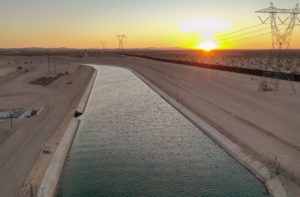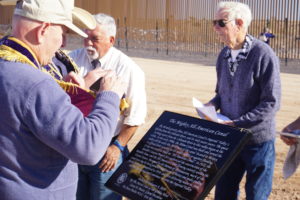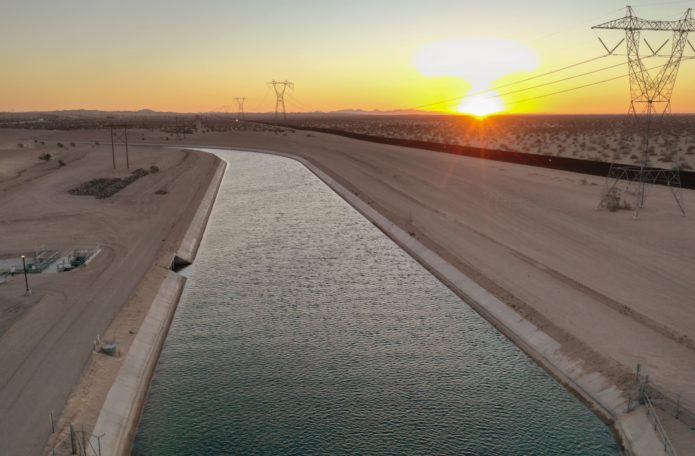
The All-American Canal is pictured during a recent January 2019 sunrise. The canal, which was sanctioned under the Boulder Canyon Project Act of 1928 and was built between 1934 and 1939, was recently honored for its historical importance by The Native Sons of the Golden West.
On a breezy perfect day in the Imperial Valley under a patchwork of purple clouds in a stretch of the county’s western desert, with Mount Signal towering nearby, a group of Valley representatives gathered to honor the All-American Canal as a historical structure. The 80-mile canal, which harnesses the Colorado River for the fertile fields of the Valley, was dedicated for its historic significance by the Native Sons of the Golden West during a ceremony held Saturday, Feb. 9, at the tail end of the canal where it meets the Westside Main Canal. During the event, a plaque made possible through a collaboration of the Native Sons and the Imperial Irrigation District, was unveiled detailing the history of the “Mighty All-American.” Just behind the plaque is the border between Mexico and U.S. and just to the west sits the remains of the original Wormwood Canal headgate, built in 1919, that enabled water from the Alamo Canal in Mexico to flow to the most western fields of the Valley.
With the roar of the river water, where the All-American meets the Westside headgates, in the background, Tina Shields—an IID water manager—told the story of the canal’s history and of the pioneering spirit that first gave rise to agriculture in the Imperial Valley. Long before the All-American Canal was sanctioned under the Boulder Canyon Project Act of 1928, pioneers saw the potential to turn the harsh desert into a landscape where agriculture could thrive by constructing canals that could direct the Colorado River into the Valley. The first attempt at this was done under the leadership of the California Company, and was called the Alamo Canal. Though it largely ran through Mexico, at headgates it fed water into the Valley. The Wormwood Canal headgate stands as a reminder of the Alamo Canal and its importance to the region.

Eric Rice, pictured to the far right, president of the Imperial Valley Chapter of The Native Sons of the Golden West, introduces the plaque dedicating the canal. The plaque, a collaboration between The Native Sons and the Imperial Irrigation District, was placed on the western portion of Imperial County where the All-American meets the Westside Main Canal.
Eventually, following the flood of 1905 that filled the Salton Sink and gave rise to the Salton Sea, and the bankruptcy of the California Company, the Imperial Irrigation District was formed in 1911 and plans began for what would become the All-American Canal. It would take the Boulder Canyon Project Act, which approved the building of Hoover Dam, to make the dream of the All-American Canal a reality. Construction on the canal began in 1934 and was finished in 1939. Water flowed through the canal starting in 1940.
In its original construction the entire stretch of the All-American was designed as an earthen canal, but under the Quantification Settlement Agreement—the series of agreements meant to reduce California’s use of the river back to its 4.4 million acre-feet allotment—a 23-mile section of the canal was replaced with a parallel concrete-lined canal in 2010. That lined section, funded by State of California and the San Diego County Water Authority, conserves over 67,000 acre-feet of water annually. In essence, along with being the lifeblood of the Imperial Valley, the canal—through the lining—has taken on a widened role of helping California and the entire Colorado River basin manage river supplies.
The dedication site has added significance in that not only does it celebrate the history of the canal, but also its future. That section of the western Imperial Valley desert along the border is the site for a potential binational turnout, which would give the canal an international importance should it come to fruition.

Pictured are the remnants of the original Wormwood Canal headgate built in 1919 to allow water from the Alamo Canal in Mexico to flow into the western half of the Imperial Valley. The old Wormwood headgate is located just yards from the plaque honoring the All-American, which replaced the Alamo. Just beyond the Wormwood headgate is the border fence.
The Native Sons of the Golden West deserve credit for honoring this critical canal. In particular, Paula McConnell Pangle—an Imperial Valley farmer and a member of the Native Sons, whose family helped build the All-American Canal, deserves credit as she nominated the canal for the dedication. IID also deserves credit for helping prepare the dedication site and for joining with the Native Sons to provide the plaque in honor of the canal.
Indeed, the All-American Canal is an example of what can occur when people with a pioneering spirit work together toward a common goal. The history that led to the building of the All-American Canal and the spirit of cooperation that made it possible still stand as a model for the management of the Colorado River today.
